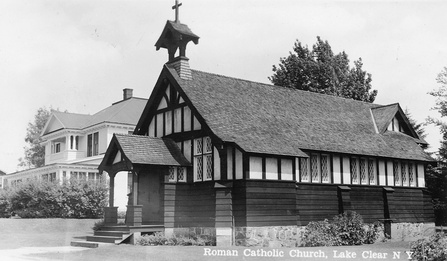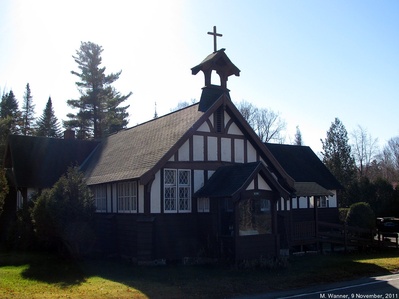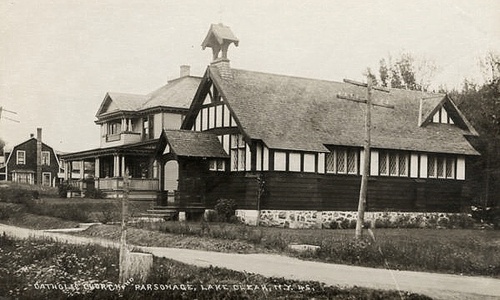
 St. John's in The Wilderness of Lake Clear interior
St. John's in The Wilderness of Lake Clear interior  6146 New York Route 30, Lake Clear Address: 6146 New York Route 30, Lake Clear
6146 New York Route 30, Lake Clear Address: 6146 New York Route 30, Lake Clear
Other names:
Year built: 1916 and dedicated in 1917; closed, and sold to a private party in 2021
Architect: possibly John T. Comes
Father John J. Waters was sent to Saranac Lake by the Bishop of Ogdensburg to start St. Bernard's Church around 1891. In addition, he established four mission chapels, traveling from one to the next on a weekly rotation, in Bloomingdale, Lake Clear, Paul Smiths and Lake Placid; these all eventually became independent parishes. He traveled from town to town on his cream-colored horse to perform his religious services.
Source: "St. Agnes, Lake Placid, New York, 1894-1984: An informal history of the Catholic community of the Olympic village."
St. John's in the Wilderness Roman Catholic Church has had alterations and additions. In 1979 the main entrance was moved from the gable end facing the road to the side toward the parking lot. The original front door has been glassed in and houses a statue.
The design is very similar to those of the Church of the Assumption in Gabriels and of St. Paul's Catholic Church in Bloomingdale.
Pastor: Rev. Mark Reilly, 2010-2012
Source: Sally E. Svenson, Adirondack Churches: A History of Design and Building, 2006, page 204.
Adirondack Daily Enterprise, October 24, 1992
St. John's celebrates 75 years in the wilderness
 Catholic Church and Parsonage, Lake Clear, N.Y., c. 1920
Catholic Church and Parsonage, Lake Clear, N.Y., c. 1920
Courtesy of Adirondack Experience
Catholicism reached Lake Clear by way of the St. Lawrence River. Actually the progression began 450 years ago in the 16th century when the French were attempting to establish a permanent colony in the new world of North America. Spain and England had gained footholds on the continent and King Francis I of France decided that it was high time to get in on the act. In 1534 he commissioned Jacques Cartier to sail for America with two ships and a crew of 120 men to explore the possibilities and return with a report.
After a lengthy crossing Cartier arrived off the coast of Newfoundland where he cruised the area in search of a suitable site for colonization. He liked what he saw and returned to France with a favorable message to the king. In the following year he made a second voyage during which he sailed into the mouth of a great river. It so happened that the date of this discovery coincided with the Festival of Saint Lawrence so ("artier named the river in his honor on that 10th of August, 1535.
For the next three quarters of a century futile exploration attempts produced no favorable results but finally, in 1609, Samuel de Champlain founded Quebec City on a high bluff over a narrow stretch of the river. This strategic site commanded a view of any naval approach up stream and offered what was considered to be a safe haven for a settlement Once the colony was established, French settlers began to arrive and with them came members of the Jesuit Order to work among the Indians.
Most noted among these intrepid missionaries was Father Isaac Jogues, who was martyred by the Mohawks on October 18th, 1646.
Despite hostile encounters Catholicism continued up the St Lawrence from Quebec City to Trois Rivieres, Mont Royal (Montreal), and Fort La Presentation (Ogdensburg). At this latter place, in 1749, Abbe Francois Picquet established a mission to serve the Iroquois Indians where the Oswegatchie flowed into the St. Lawrence.
Another hundred years later Notre Dame Church was dedicated with Father Jean Lemercier as the first pastor in 1859. On October 2, 1969 a second Catholic Church was founded when St. Mary's became the third place of worship to locate at Ogdensburg. Three years later Pope Pius IX formally established the Diocese of Ogdensburg on February 16,1872.
Catholicism was coming closer to Lake Clear!
With the coming of spring on May 16th, Bishop Edgar P. Wadhams arrived at St. Mary's to become the first Bishop of Ogdensburg. He had been elevated to the bishopric only eleven days earlier by Archbishop McCloskey at the Cathedral of the Immaculate Conception in Albany and was immediately assigned to the newly formed sec on the St Lawrence. At that particular time, the Diocese covered some 12,000 square miles, embracing a population of 290,000 souls.
Within this perimeter of advancing faith there remained much wilderness. Paul Smith had built his famous hotel on Lower St. Regis in 1858 and recreation had become a new industry.
Judd Nonhrup [sic: Northrup?], a journalist-sportsman in 1881, was taking the popular guideboat trip from Paul Smith's to Martin's Hotel on Lower Saranac Lake. While making the St. Germain Carry between Upper St. Regis and Big Clear Pond, he met and joined another party from Paul's. While crossing Big Clear, they boated from the North shore to the South shore landing where a horsedrawn wagon would carry the boats to Saranac Inn for the next leg of their journey.
A guide with the party called out to summon the owner of the wagon transport, and while waiting, Northrup noted the scene before him. He wrote a description briefly as "two or three houses in the midst of a small clearing by the shore." Of prior interest to us is that this little clearing would later prove to be the area where St. John's In The Wilderness Church would be erected.
In all of the early Adirondack maps and guide books our lake appeared as Big Clear Pond. Both Big Clear and Little Clear were apparently named for their clarity of spring fed waters and both bodies of water served as links in the connecting chain of lakes and streams that made up the novel transportation system so peculiar to our Adirondack region.
From the mid 1800s and on into the teenage 1900s the lumber industry was making bold inroads into the wilderness. As each major sawmill began operation, a boom-town settlement was established with housing for the workers, a general store, a hotel, a school and finally a church. Since the majority of the lumberjacks and river drivers were French Canadians, they were of the Catholic religion. This faith was undoubtedly related to the Jesuit influence that had fostered Catholicism among their ancestors in Canada.
Two of the lumber towns that prospered in our proximity were Brandon and Derrick and both supported a Catholic Church. At Brandon, St. John the Evangelist Buck Mountain Church was incorporated the 1st of March in 1888. The "Buck Mountain" nomenclature was adopted from the adjacent hill where the cutting was taking place. The church was built in 1889 and the First Pastor was Rev. F. Lussier. It remained a parish from 1888 through 1901 and from 1902 to 1909 it became a mission of Derrick.
Timber was depleted early at Brandon, but the hamlet of Derrick lasted for another 30 years. St. Anthony's Church was founded there in 1902 by Rev. Joseph Hervieux and remained a parish until 1910. From 1911 until 1930, St. Anthony's became a mission of St. John In The Wilderness at Lake Clear. The name change from Big Clear Pond to Lake Clear took place about the time of the railroads arrival in 1892, when the station became Lake Clear Junction.
St John In The Wilderness Church was incorporated on May 8, 1910 with Father Emile Berard becoming the first pastor. There apparently was some prior movement to form a church because the first land deed was dated July 11, 1887 with property being acquired from The Ducey and Backus Lumber Co. (the founders of Brandon).
Here we have the complication of two separate churches on two adjacent sites. The first church was located on the north side of the highway between the present road and the lake. This church was dedicated in 1906 with Edward Patnode and Henry F. Ryan as trustees. It remained as a mission of St. Anthony's at Derrick until 1910 when the vagaries of fortune reversed the situation with Derrick becoming the mission of Lake Clear.
While this was taking place, and prior to St. John's formation, at Paul Smiths another Catholic Church was being organized. On August 16, 1894, Bishop Gabriels blessed the Church of The Angel Gabriel which was built on land donated by Paul Smith. Under the guidance of Father Ferdinand J. Lussier, St. Gabriels served as a mission to other parishes such as Black Brook, Brandon, Derrick, and finally to Lake Clear from 1911 to the present time. As mentioned earlier, Father Lussier had formerly been the pastor at Brandon's St. John the Evangelist Church. When the building of St. Gabriels was completed in 1896, it was blessed by the Rev. Michael Holland. Strangely enough, the land deed was dated September 30, 1896, two years after the church had been organized and the incorporation date much later on December 27, 1941, under the pastorship of Father Edgar A. Gallagher, formerly of St. John's at Lake Clear.
Returning to the story of St. John's two churches, there are conflicting stories of both their origin and their demise. Older residents recall that a church did exist on the opposite side of the road from the present church where the James Moscatello summer camp is currently located. Some insist that this church burned at an indefinite date, but at least one photo shows both churches in existence in 1933. If a church did burn prior to 1933, there is no mention of this in the History of the Diocese of Ogdensburg, where only two dedications are listed (1906 and 1917). It might be possible that the 1906 was destroyed by fire and was rebuilt without a second dedication. Lending credence to this assumption, is the existence of separate photos showing the earlier church placed parallel to the highway, while the 1993 photo depicts the church at right angle to the road.
Further complications arise with the personal memories of former parishioners. One such recollection relates that the very first St. John's Church was in a renovated hay barn. There also is a reference to a "little white church" loaned to the parish by The Wright family. In any event the property on the north side of the highway was apparently acquired by Mr. Wenner, who sold to George Stearns, who in turn sold to Mr. Moscatello. A portion of this lot, between the road and the lake, is still owned by the church.
Taking into consideration the speculative nature of some of this material, we had best digress to matters that pertain to the present St. John In The Wilderness Church of Lake Clear.
In 1914 Mr. Clarence Mackay, a wealthy individual connected with silver mines and international telegraphy, donated funds for the construction of a new Catholic Church to be built in Lake Clear. Mr. Mackay's daughter, Ellen, was the wife of Irving Berlin. Property was acquired on the south side of the highway and the cornerstone laid in 1916. On September 12, 1917, Bishop Conroy came to dedicate the new church by retaining the original title of St. John In The Wilderness. Among the original families who were members of the parish were David and Nancy Patnode, Frank and Josephine Gillmett, and George and Rose Douglass. Among later parishioners who dedicated their lives to the service of God are Father Paul Oehler and his sister, Sister Mary Karl Oehler, of the Immaculate Conception. Father Paul was ordained in May, 1959 and served as a Chaplain in the U.S. Army at Fort Sill. Sister Karl was professed in 1943 and became a Franciscan Missionary of The Sacred Mean at the Peekskill Motherhouse in North Tarrytown.
Many changes have taken place during the ensuing 75 years. The much revered marble altar was removed when dictates of Mother Church updated procedures to conform with practices whereby the priest would face the congregation and lead the Mass in English, rather than in Latin. Some structural changes also occurred in the building itself with the addition of a parish hall in 1967 and in 1979 when the main entrance was relocated from the facade to the side facing the parking lot. Earlier, in 1957, a parcel of land containing 3,283 square feet had been acquired from Cecil Sochia to square off the southwest comer of the parking area. (The original lot containing the church, rectory and garage amounted to 52,297 square feet).
In 1959 a Lake Clear Catholic Cemetery was formed to fill a need for this necessary function and the grounds have been maintained and improved by the Cemetery Committee during the past 33 years. Located on Route 30 just north of Lake Clear Junction, the land was donated by the Paul Smiths Company and is located only a mile and a half from the church.
During 1983 the interior of the building was completely renovated with a knotty pine decor which lends a rustic atmosphere very suitable to our Adirondack setting. The main body of the church can hold 110 parishioners, but during the summer season when campers and visitors arrive, the overflow is seated in the adjoining church hall.
An added attraction during the summer vacation months is the 10:00 a.m. Mass on Sundays which is celebrated at the New York State Fish Creek Campsite some 8 miles to the west. Also, during this brief, but enjoyable time of the year, a series of camp seminars is offered at the Guggenheim Center on Lower Saranac Lake for both youth and adult enjoyment. A gift from the late Edmond Guggenheim to the Catholic Church, the camp is thus utilized to meet a vacation experience in a Christian environment.
The most recent addition to the church began in 1984 by Father Vinny Flynn, with the idea of an alcove to replace the former entrance. Fr. Tom Moody obtained a statue of St. John, saw the project through to the blueprint stages and the project was completed by Father Bruce Favreau in October, 1991 with the statue of St. John enclosed in a glass shrine.
This year (1992) is a banner year in the category of anniversaries. The discovery of America by Christopher Columbus celebrated its 500th anniversary while both Saranac Lake Village and the Adirondack Park are enjoying centennial festivities. St. Bernard's School reached its 70th birthday in September, but most important to the parishioners of St. John's is, of course, the 75th anniversary which was celebrated on September 13th. This gala occasion commenced with Benediction of the Holy Eucharist, and was followed by a picnic sponsored by the anniversary committee.
The procession of advancement of Catholicism has been long and rewarding here in our north country. The French-Canadian influence seems to have been reflected in the surnames of our early pastors: Picquet at Ogdensburg in 1749, Lemercier also at Ogdensburg in 1859, Lussier at Brandon in 1888, Hervieux at Derrick in 1902, and Berard at Lake Clear in 1910. Certainly the initial missionary efforts of the Jesuits from France established a succession of devout Catholic generations along the St. Lawrence. From the martyrs of the 17th century to our present membership in the Diocese of Ogdensburg we owe our heritage to these pastoral pioneers whose dedication and perseverance overcame all hardships while bringing Christianity to our midst here at Lake Clear.
Today, we are prone to take for granted all of those clerical advantages which we arc able to enjoy through the many sacrifices of our Catholic predecessors. May we always appreciate these religious privileges through the grace of God in the furtherance of Christianity here at St. John In The Wilderness Church for another 75 years!
See "Lake Clear News: A little bit of history on Lake Clear" by Deborah Donaldson, November 18, 1998, for a list of pastors and the dates they served, also from John Duquette.
See "Former Lake Clear Catholic church being sold; St. John in the Wilderness was downgraded to oratory six years ago," Adirondack Daily Enterprise, March 18, 2021.
See also:



